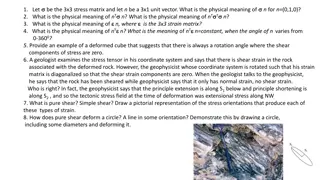Enhance Your Fitness Journey: Core Strength and Speed Workouts
Explore the importance of core strength in maintaining posture and physical performance, engage in a virtual group challenge to test your endurance with wall planks, and boost your core strength with a practical 7-minute workout. Transition into focusing on speed with insights into sprinting, cyclin
0 views • 38 slides
Understanding the Rule of Mixtures in Composite Materials
The Rule of Mixtures (ROM) is a weighted method for predicting the properties of composite materials, such as fiber-reinforced polymers (FRP). This method relies on assumptions regarding the homogeneity and properties of fibers and matrices. By combining volume fraction and properties linearly, the
5 views • 23 slides
Understanding Pharmaceutical Calculations: Altering Product Strength and Solutions
Pharmaceutical calculations involve altering the strength of pharmaceutical preparations by adjusting the proportion of active ingredients, using stock solutions, and problem-solving techniques. This process includes dilution, fortification, and concentration changes to achieve desired product stren
7 views • 23 slides
Understanding Extreme Value Theory in Civil Engineering
Introduction to Extreme Value Theory (EVT) in civil engineering focusing on the analysis of extremes such as shear strength, slope stability, and load factors. The theory, exemplified by Emil Julius Gumbel, questions the likelihood of individual observations falling outside expected distributions. E
10 views • 49 slides
Understanding and Utilizing the Bursting Strength Tester: A Comprehensive Guide
In the world of material testing, ensuring the strength and durability of products is crucial. One essential tool that plays a pivotal role in this process is the bursting strength tester. This device helps manufacturers and quality control professionals measure the bursting strength of various mate
6 views • 5 slides
Testing Methods for Textile Fabrics Breaking Strength and Elongation
Standard testing methods, ASTM D5034 and D5035, are used to determine the breaking strength and elongation of textile fabrics through grab and strip tests. The grab test measures the effective strength of fabric using adjacent yarns, while the strip test compares the strength of unwoven yarns. Appar
0 views • 29 slides
Pharmacy Practice: Percentage and Ratio Strength Calculations
Understanding percentage and ratio strength calculations is crucial in pharmacy practice. Percentages can be expressed as fractions or decimals, and various concentrations like weight-in-volume and volume-in-volume are used in pharmaceutical preparations. Learn how to calculate the correct strength
0 views • 24 slides
Understanding Strength-Duration (SD) Curve: A Neuromuscular Diagnostic Test
Strength-Duration (SD) curve is a diagnostic test assessing neuromuscular integrity by measuring the relationship between stimulus strength and duration. It helps in electro-diagnosis of peripheral nervous system disorders and evaluates nerve degeneration and regeneration. The curve is obtained by p
2 views • 17 slides
Understanding Internal Loadings in Structural Members
Internal loadings in structural members, such as beams and frames, are essential for design. This chapter explores the analysis of shear forces, bending moments, and axial forces, providing methods to determine these forces graphically using shear and moment diagrams. Learn about the sign convention
0 views • 35 slides
Understanding Plane Failures in Rock Slopes
Plane failures in rock slopes are rare but significant, indicating sensitivity to changes in shear strength and groundwater conditions. Geometrical conditions must be met for such failures to occur, including specific alignments and interactions between the sliding plane and slope face. Analysis inv
0 views • 22 slides
ASTM D3786/D3786M-18 Standard Test Method for Bursting Strength of Textile Fabrics
This standard test method, ASTM D3786/D3786M-18, specifies the procedure for determining the bursting strength of textile fabrics using a diaphragm bursting strength tester. The test involves clamping the specimen over an expandable diaphragm and applying pressure until the fabric ruptures. The burs
0 views • 16 slides
Understanding Pharmaceutical Product Strength Alteration
Exploring methods to adjust the strength of pharmaceutical preparations by manipulating the proportion of active ingredients, dilution, concentration, and the relationship between strength and total quantity. Learn about solving problems related to altering product strength using inverse proportion,
0 views • 17 slides
Understanding Pharmaceutical Preparations: Strength and Concentration
Pharmaceutical preparations can have their strength and concentration adjusted by changing the proportion of active ingredients. This process involves increasing or decreasing the active ingredient, adding diluents, admixing with other preparations, or evaporating the vehicle. Dilution of liquid, so
0 views • 34 slides
Understanding Viscoelasticity and Relaxation in Amorphous Materials
Dive into the world of viscoelasticity and relaxation in amorphous materials, exploring concepts like complex shear modulus, Maxwell element, and phenomenological models. Discover the intriguing nature of glass, its transition between solid and viscous states, and the various theories surrounding it
1 views • 34 slides
Understanding Unique Aspects of Ship Structures
Ships have complex three-dimensional shapes and support structures to withstand dynamic loads in various environments. Structural loads such as weight and buoyancy are distributed forces that affect shear stress in ship structures. Strategies to reduce shear stress include matching buoyancy and weig
0 views • 58 slides
Understanding Shear Stress in Mechanics of Materials
Shear stress is a critical concept in Mechanics of Materials, describing the stress parallel to a surface due to applied forces. This stress is crucial in various applications like metal joints, punching operations, and more. Shear stress calculations can help engineers determine the strength and du
0 views • 19 slides
Insights into the Low-Latitude Boundary Layer in Mercury's Magnetosphere
Study focuses on the low-latitude boundary layer (LLBL) in Mercury's magnetosphere, analyzing magnetosphere and magnetosheath plasma characteristics such as reconnection rates, IMF/magnetic shear, and plasma beta. Results show anti-correlation between LLBL and non-LLBL regions, with different reconn
0 views • 11 slides
Unstable Weather Alert: Tropical System Impact and Shear Line Approaching
Tropical system passing north, bringing heavy rainfall and unstable air. Expect convective showers, tailwinds on landing, and shifting precipitation patterns. Concerns about tropical showers, moisture levels, and shear line impact on landing and takeoff conditions. Images of weather situations provi
1 views • 10 slides
Experimental Study on Wind Shear Effects on Laser Propagation
Research conducted by Joe Watkins, Reza Malek-Madani, and Svetlana Avramov-Zamurovic to analyze the impact of wind shear on laser propagation. The experiments involved a HeNe red laser passing through a tunnel with varying wind speeds. Data on light intensities and wind influence were collected and
0 views • 7 slides
Understanding Beam Elements and Shear Effects in Structural Analysis
Beam elements play a crucial role in structural analysis, offering insights into line elements with various degrees of freedom for bending modes and stress analysis. Shear deflection and stresses in beams are essential considerations when accounting for shear effects. Learn about real constants, sha
0 views • 16 slides
Understanding Shear and Moment in Beams
Beams play a crucial role in mechanical engineering, with two main types - statically determinate and indeterminate beams. Explore the definition of beams, loading types, and the concept of shear and moment diagrams to understand the behavior of beams under different loads and reactions. Learn how t
0 views • 8 slides
Cosmic Shear Measurement in Fourier Space and Its Scientific Goals
Exploring the cosmic shear in Fourier space with a collaborative effort led by Jun Zhang from Shanghai Jiao Tong University sheds light on fundamental scientific questions related to dark energy, the geometry of the universe, General Relativity, cold dark matter, and cosmic structure density distrib
0 views • 48 slides
Research on Stratospheric Polar Vortex and TPVs for Arctic Cyclone Predictability
This research aims to enhance predictability of Arctic cyclones by studying the Stratospheric Polar Vortex and Tropopause Polar Vortices (TPVs). The presence of strong westerly winds in the stratosphere during fall leads to anomalous cold air outbreaks in mid-winter. TPVs serve as precursors to arct
0 views • 4 slides
Influence of Vertical Wind Shear on Entrainment in Squall Lines
The strength and direction of low-level (LL) and upper-level (UL) wind shear influence the properties of squall line updrafts, with stronger shear environments fostering wider updrafts that are less susceptible to entrainment-driven dilution. The relative influences of LL and UL shear on this relati
0 views • 40 slides
Persistence of Langmuir Modes in Complex Shear Flows
Exploring the persistence of Langmuir modes in kinematically complex plasma flows with a focus on shear flows in nature and historical backgrounds. The research delves into the methodology of classical theory and introduces the nonmodal approach to address limitations. Details on shear flow definiti
0 views • 16 slides
Total Body Push Pull Rotate Training for Strength and Endurance
Total Body Push Pull Rotate Training helps improve muscular endurance and strength by alternating exercises from different strength training categories. The workout consists of choosing exercises from push/pull categories and incorporating rotational movements for a comprehensive full-body workout.
0 views • 5 slides
Understanding Viscous Fluid Behavior in Engineering Applications
Viscosity is a crucial property in fluid mechanics, impacting how fluids deform and move. Engineers measure viscosity using factors like resistance to deformation and fluid behavior classifications such as Newtonian, shear thinning, shear thickening, and Bingham plastic. This knowledge is essential
0 views • 7 slides
When I Am Weak, Then I Am Strong: Understanding Strength in Weakness
In 2 Corinthians 12:6-10, the apostle Paul reflects on how a thorn in the flesh humbled him, leading to a greater understanding of God's grace and strength in weakness. This passage emphasizes that true strength is found in acknowledging our dependence on Christ, allowing His power to be perfected i
0 views • 7 slides
Bridge Evaluation and Route Planning: Ensuring Structural Integrity
Thomas Beitelman, a State Bridge Evaluation Engineer at the Florida Department of Transportation, shares insights into the evaluation of routes for large haulers, overcoming challenges such as dimensional rejections and overloaded structures, and making informed decisions to ensure safety and compli
0 views • 8 slides
Understanding Plain & Reinforced Concrete Structures in Design Engineering
In the design of Plain & Reinforced Concrete structures, various strength design methods such as Ultimate Strength Design (USD) and Allowable Strength Design (ASD) are utilized. These methods involve factors of safety, material strength, load factors, and analysis in the elastic range. Additionally,
0 views • 11 slides
Describing Rheological Properties of Unknown Materials - In-Class Activity (Spring 2015)
Explore the rheological properties of unknown materials in a hands-on in-class activity. Students work in teams to identify whether samples are pseudoplastic, Newtonian, or dilatant fluids based on viscosity changes with shear rate. Corn syrup, corn starch, icing, and toothpaste are analyzed, with f
0 views • 5 slides
Engineering Uses of Rocks in Civil Engineering - CE 260 Soil and Rock Mechanics
Rocks play crucial roles in civil engineering as building materials and foundations. Understanding rock properties such as strength and deformability is essential for assessing aggregate quality and ensuring proper structural support. Key properties include intact rock characteristics, discontinuiti
0 views • 14 slides
Macromechanical Analysis of Lamina and Tsai-Hill Failure Theory Overview
The Tsai-Hill failure theory is based on the strengths of a unidirectional lamina, incorporating longitudinal and transverse tensile and compressive strengths, as well as in-plane shear strength. This theory, derived from the distortion energy theory, provides criteria for determining lamina failure
0 views • 15 slides
Understanding Shear Strength in Engineering Materials
Shear strength is a crucial mechanical property that defines a material's ability to resist forces causing internal structure to slide. This property plays a significant role in various engineering fields, impacting design, construction, and material selection. Shear strength is essential in prevent
0 views • 31 slides
Understanding Capillary Rheology: A Guide to High-Shear Behavior
Capillary rheology is a study of materials that flow, combining properties of liquids and solids. By passing liquids through small tubes, capillary rheology allows for the analysis of high-shear behavior, crucial for processes like extrusion and coating. Learn about the basic terms, anatomy of a cap
0 views • 29 slides
Understanding Deformation and Strain in Engineering
Deformation occurs when a force is applied to a body, causing changes in its shape and size. Normal strain refers to the elongation or contraction of a line segment per unit length, while shear strain is the change in angle between two originally perpendicular line segments. Cartesian strain compone
0 views • 6 slides
Macromechanical Analysis of Lamina Failure Theory
The failure theories in macromechanical analysis are based on the normal and shear strengths of a unidirectional lamina, with five strength parameters. A lamina is considered failed if certain criteria related to ultimate strain values are violated. In a specific example with a Graphite/Epoxy lamina
1 views • 10 slides
Understanding Strain and Stress: Concepts and Applications for Geologists and Geophysicists
This content delves into various aspects of stress and strain in the context of geology and geophysics, exploring the physical meanings of unit vectors, stress matrices, strain matrices, pure shear, simple shear, and their implications on deformation characteristics. It also discusses scenarios wher
0 views • 4 slides
Understanding Concrete Strength in Structural Design
Concrete strength, including compressive, tensile, and flexural strengths, plays a crucial role in structural design. Compressive strength is the main quality criterion, while tensile strength is lower due to concrete's brittleness. Flexural strength also impacts the behavior of structural members.
0 views • 17 slides
Importance of Mechanical Properties in Materials Science and Engineering
Mechanical properties play a crucial role in designing materials for high strength, understanding real-life performance, and correlating with structure. Key concepts include stress, strain, tension tests, compression tests, shear tests, and torsional tests, which help in assessing a material's behav
0 views • 10 slides







































